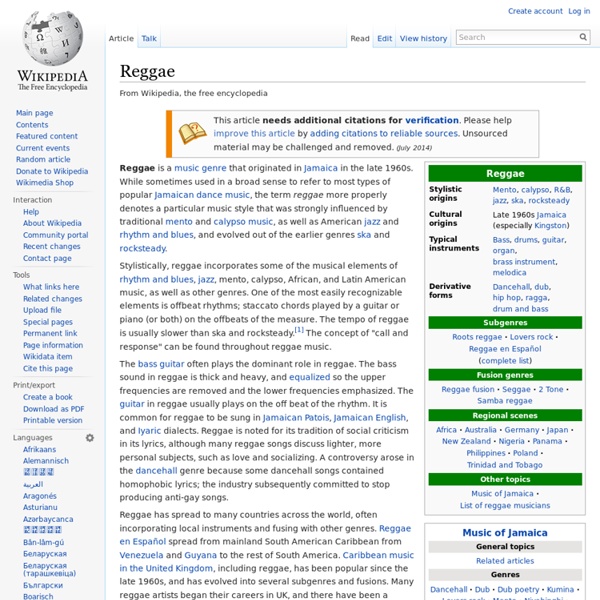Reggae
Bob Marley and the Wailers, 1980 Reggae is a kind of music from Jamaica. Most music from Jamaica can be called reggae. Reggae music is often used by Rastafarian groups. Famous instruments in reggae music are drums, guitar, saxophone, trumpet and trombone. Reggae was started in 1960 but became famous in the 1970s. Reggae songs often have lots of backing singers. Rapper Snoop Dogg released an album of reggae music in 2013.[1] Reggae is related to ska.
Ska
Ska is a kind of popular music from Jamaica that was developed in the 1950s. Ska music played at a slower tempo turned into reggae in the late 1960s. How it sounds[change | edit source] In ska, the electric guitar and piano normally play short chords on the off-beat. If you go "one and two and three and four", the off-beat is the "And". In ska, the singer does a style of Jamaican singing called "toasting." How Ska musicians dress[change | edit source] Musicians who play ska dress in hats and suits. 1980s Ska Revival[change | edit source] Even though ska was developed in the 1950s, it became popular again in the 1980s in Britain. 1990s Ska mixed with punk rock[change | edit source] In the 1990s, some bands mixed ska music with Punk rock to make ska-punk. Examples of Ska Bands:
Reggae Music 101 - A Quick History
By Megan Romer The Beginning: Reggae is a genre that grew out of several other musical styles, including both traditional and contemporary Jamaican music, like ska and mento, as well as American R&B. In the early days of radio, stations were super-high-powered, and several stations from Florida and New Orleans were powerful enough to reach Jamaica, thus the R&B influence. Reggae evolved from these other genres, and really emerged as a unique form in the late 1960s. Characteristics of the "Riddim": Reggae is characterized by a heavy backbeated rhythm, meaning the emphasis of the beat is on, for example, beats 2 and 4, when in 4/4 time. Rastafarianism: Rastafarianism is a religion that is very common among Jamaicans of African descent. continue reading below our video Popularity of Reggae in the United States: Bob Marley was reggae's best-known international ambassador. Marijuana and Reggae: Read More: Why Did Bob Marley Smoke Marijuana? Reggae Language: Reggae's Influence: Reggae Starter CDs:
Rocksteady
Rocksteady is a music genre that originated in Jamaica around 1966.[1] A successor to ska and a precursor to reggae, rocksteady was performed by Jamaican vocal harmony groups such as The Gaylads, The Maytals, The Heptones and The Paragons. The term rocksteady comes from a dance style that was mentioned in the Alton Ellis song "Rock Steady". Dances performed to rocksteady were less energetic than the earlier ska dances. The first international rocksteady hit was "Hold Me Tight" (1968) by the American soul singer Johnny Nash; it reached number one in Canada.[2] Characteristics[edit] Rocksteady uses some of the musical elements of rhythm and blues (R&B), jazz, ska, African and Latin American drumming, and other genres. The fact that chording instruments (instruments that play chords) in ska, rocksteady, and reggae often play so infrequently in the bar and play repeated rhythmic patterns led Jamaican musicians to explore simple modal chord progressions such as I - VII or I - IV. Lyrics[edit]
Ska
Etymology[edit] There are different theories about the origins of the word ska. Ernest Ranglin claimed that the term was coined by musicians to refer to the "skat! skat! skat!" History[edit] Byron Lee & the Dragonaires performed ska with Prince Buster, Eric "Monty" Morris, and Jimmy Cliff at the 1964 New York World's Fair. 2 Tone[edit] Third wave [edit] Third wave ska originated in the 1980s and became commercially successful in the 1990s. United States[edit] The mid-1990s saw a considerable rise in ska music's underground popularity, marked by the formation of many ska-based record labels, booking organizations and indie zines. By the late 1990s, mainstream interest in third wave ska bands waned as other music genres gained momentum.[35] Moon Ska Records folded in 2000, but Moon Ska Europe, a licensed affiliate based in Europe, continued operating in the 2000s and was later relaunched as Moon Ska World. United Kingdom[edit] Germany, Australia, Japan and South America[edit]



